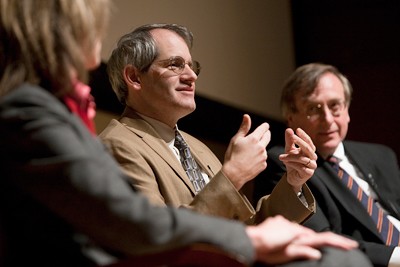Faculty and staff query administrators on budget model
By Susan Kelley
How much undergraduate tuition funds would come to each college? Which university revenues would be taxed, and how much, to fund university initiatives?
The faculty and staff members who asked these questions at a subdued Feb. 11 public discussion on the proposed budget model in Statler Auditorium won't get answers any time soon. The provost first has to choose a model and then form an implementation committee, which will hammer out the details of how the model will work. The university will adopt a new model by July 1, 2011.
Provost Kent Fuchs acknowledged that many on campus are anxious to see what resources the new budget model would provide for their unit when implemented. "That's the message I'm getting from the college deans: 'Principles are great, Kent, but tell us whether our budget goes up or down in this new model.'"
Fuchs hosted the event, with budget model task force co-chairs Paul Streeter, associate vice president for planning and budget, and Cathy Dove, associate dean of administration in the College of Engineering.
Streeter said that the task force's main recommendations included the establishment of a single campuswide model that would be simple, understandable and predictable and would help enhance academic excellence. Second, the model would pool undergraduate tuition, which the Office of the Provost would redistribute to colleges, based on such various considerations as students' college of enrollment and college of instruction, the cost of instruction and established university priorities. Third, the model would create a fund with which the provost could support institutional priorities, funded by a percentage of revenues. The task force suggested that this fund would total around 10-15 percent of the total unrestricted resources, or approximately $125 million to $175 million.
Audience members mostly asked how exactly the proposed model would affect specific units and colleges.
Barbara Knuth, natural resources professor and senior associate dean in the College of Agriculture and Life Sciences, suggested that the implementation committee consider the different ways colleges operate when it plans how to distribute undergraduate tuition back to the colleges. "For example, a typical course in the College of Agriculture and Life Sciences may be three credits, where a typical course of the same design might be four credits in another college," Knuth said.
Distribution would be based in part on college of instruction, Dove said. "And that's where it starts getting complicated, between credit hours, the cost of instruction, etc. There are a number of factors that really need an implementation group to work through that."
Stephen Pope, professor of mechanical and aerospace engineering, asked how the budget model would encourage individual faculty members to improve the university's academic excellence. The task force did not address that aspect of the model, Fuchs said. "My expectation would be to leave that decision on how to distribute resources within a college to the deans and chairs to figure out, depending on the culture and resources of the college."
Would any of the provost's university initiatives fund go to nonacademic units, asked Therese O'Connor, Cornell Dining's training coordinator. Yes, it's possible, Fuchs said. The new model would include clear guidelines as to how nonacademic and academic units could seek funding from the resources available, he added.
Fuchs is soliciting feedback on the task force recommendations. In late spring, he will announce the budget model the university will adopt and will then form the implementation committee.
Media Contact
Get Cornell news delivered right to your inbox.
Subscribe